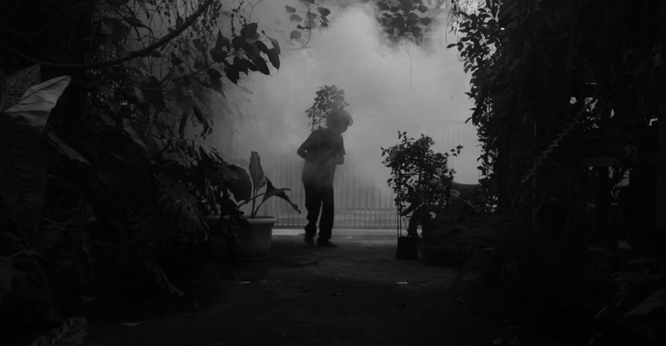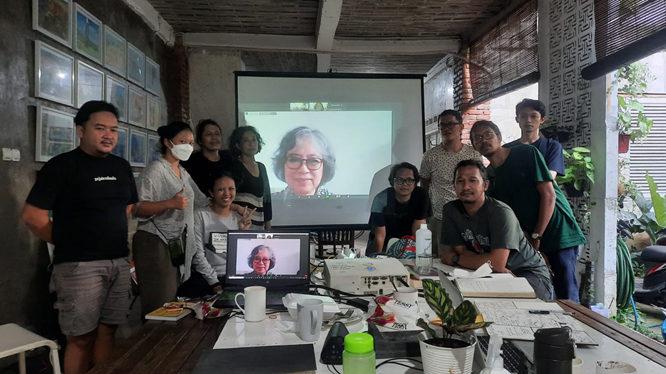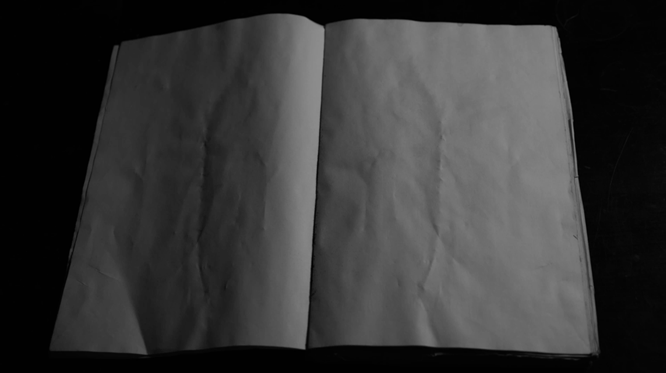

The dream of artist’s movies was always a thousand plateaus. In place of capital cities and red carpet affairs, there would be a dispersed horizon of micro-scenes, each unlike anything else, offering different ways to make, show and distribute. The fringe long ago understood the intimate relation between production and exhibition. To create a culture—even, and especially, an alternative culture—it would be necessary not only to provide tools for production, but also to invent new kinds of frames where people could gather, unlearn the old codes, fall in love.
Indonesia’s alternative film culture has been inspired by Forum Lenteng, a collaborative enterprise that is also an experiment in living. On the outskirts of Jakarta, a small cohort lives together in a house that is also a community centre, a school, a 25-seat movie theatre and ARKIPEL—Jakarta International Documentary Experimental Film Festival (founded in 2013). First fest director Yuki Aditya offered me a pair of motivating questions for their efforts: “How to produce and distribute knowledge through film festivals. How to amplify social/political issues in an audiovisual medium?” He added, “The terms ‘experimental’ or ‘documentary’ barely existed [in Indonesia] before ARKIPEL. We wanted to expand the definitions of these terms.” [1]
For this cinema collective, the central question of collage—how these pieces fit together—is undertaken in a communal living that frames all of the group’s activities. Who will clean up the dishes, who will sweep the stairs, are also questions of how to organize collectively, how to create the conditions for new forms of cinema. Yuki Aditya: “It is not always about fighting the system, but being together, making something together. Being in a collective is in our blood, probably derived from the spirit of agricultural society.”
“Art for us is another form of politics.” — Van Luber Parensen
Forum Lentengruns a radical film school. Every year, a public call brings a dozen participants together for six months, forming a collective called Milisifilem that meets every Friday and Saturday. They absorb historical art and cinemas, and conclude by making films. The heart of the sixth workshop (in 2023) centred on the work of Indonesian counter-culture hero Pramoedya Ananta Toer (1925–2006). A fearless advocate for human rights and a prolific writer, he was jailed as a political prisoner both by Dutch colonizers, from 1947 to 1949, and by successive Indonesian governments, in 1960 and from 1969 to 1979, who eventually exiled him to the distant island of Buru. During the last decade he spent imprisoned, he “wrote” his best-known work: the Buru Quartet, four historical novels set during Indonesian independence. He was forbidden even a pencil, but he spoke them out loud to other prisoners who wrote them down. They were smuggled out of the country by a friend and translated into over 20 languages. These complex narratives blend personal experience, anti-colonial perspectives and fictional characters, and became study guides and inspiration for a new cohort of student makers at Forum Lenteng in 2023. Imagine a film school where the writings of a radical dissident are the central character. The frame of these revolutionary books created conditions for new ways to imagine cinema, for the colonialism of state and self.Little wonder then, that my favourite film of the year emerged from this cohort.

[Forum Lenteng 2021]

:: The Sparrow in the Storm (2023) [Van Luber Parensen]
The Sparrow in the Storm (Pipit Dalam Badai) was made by Van Luber Parensen. He was born in Sumatra (like my mother), but he moved at the age of two with his parents to Jakarta “to have a better life,” as he told me, like too many in his country. The Dutch made it the capital of the Dutch East Indies, and owing to a cruel colonial legacy, it remained the capital for decades, stuffed with schools, jobs and cultural opportunities, while Indonesia’s other islands, of which there are more than 14,000, had less. As Van Luber related over Skype, “What happened in the past is still happening.”
Pipit begins in a dream of white smoke, the camera perches in a dark and teeming wildlife that frames a moment of the city, where a uniformed man sends a white spray billowing skywards. It is aimed at mosquitoes, the unwanted residents of this neighbourhood. The fog creates a frame for understanding the world of this film, a place where right and wrong walk together, where it can be difficult to distinguish where the wounds of colonialism end and personal tyrannies endure.
After his departure, a man wearing an oversized bike helmet smuggles a plant into this public space, hoping to save it from pesticides. Welcome to a city of mystery and secrets drenched in a casual and effortless beauty. A close-up hand guides us through a book that consists of plants pressed flat against its pages. As if the plants themselves were a language waiting for readers to catch up to their urgent messages. Van Luber: “Biology as an academic project came from modernity, which was brought by the Dutch.” While plants are overflowing in the city’s shadows, the scientist tries to capture and name dead specimens in this book. “‘Pressed’ plant specimens emerged as a crucial method of scientific identification and classification.” [2] The colonial project names certain plants “weeds,” or “invasive species.” It introduces plants from other countries in order to contain local populations. Nutmeg, peppers, cloves and cinnamon were augmented by the Dutch with new crops never seen in the islands before: coffee, tobacco, sugar, opium. Plants became the cornerstone of a new global economy, colonial signatures.
This book without words tells a big story: the conversion of the world’s peoples, plants and minerals into money. So much is conjured in a single image. It is followed by an achingly slow tilt up a tree, extravagant in years and foliage, as if we were watching a tree look at another tree. I am this book, this leaf, this tree. A voice-over begins, drawn from the second book of Pramoedya’s Buru Quartet, named Child of All Nations (1980). It gives voice to a letter written by Miriam de la Croix, a European, who is writing to Minke, an Indonesian and the book’s main character.
“Dreams of sailing north have always been considered a premonition of death by your people,
haven’t they?” [3]
Ironies and contradiction abound in the letter. It is sent by someone “from the north”—from the colonizer, the death merchants, though it is signed by “your friend.” The letter says that, even while the north continues to trample the islands, its citizens dream of escaping to that starry destination. “All you get is their garbage and their disease,” the Euro lady (played by an Indonesian) declaims in a soft and soothing voice, as she describes Indonesian customs to her Indonesian audience.


:: The Sparrow in the Storm (2023) [Van Luber Parensen]
Meanwhile, three kids and their scientist father stroll the neighbourhood or play in the backyard (the courtyard of Forum Lenteng). Father names the rivers, and tries to interest his kids in books, but they are busy playing, interrupting, laughing, being. He embodies a colonial legacy of science and control, while the children appear as an easygoing Indonesian resistance. The camera stays low to the ground, taking a child’s perspective (these are actually the children of the 37-year-old filmmaker, no wonder they’re so comfortable with the camera quietly moving so close to them). The camera is always handheld, these views are a symptom of contact, the evidence of a body in relation to other bodies. The camera is not an instrument of examination, but a tool for being with.
“In Europe, human beings collapse before a bunch of protozoa named capital.” [4]
This essay film is also a home movie, a fiction, a poem of resistance that unfolds in a fog of indistinct boundaries. A sophisticated anti-colonial document, it reflects on the ways “Europe” lives on as wound and dream destination, as the gateway to modernity that creates a terrifying cascade of separations—between human and non-human, fathers and children, flower and weed, master and slave. As a reflection on reflections, it doesn’t come to any conclusions, it’s hope is to set thought into motion in a suite of beautiful frames that carry the pulse of life itself, all buoyed by comrades at the co-op, pitching in to make it all possible.
[1] All quotes from Yuki Aditya and Van Luber Parensen in this article are taken from Skype calls with the author of this article, in October 2024.
[2] Banu Subramaniam, Botany of Empire: Plant Worlds and the Scientific Legacies of Colonialism, 49.
[3] Pramoedya Ananta Toer, Child of all Nations, 55.
[4] Ibid, 102.
*
Mike Hoolboom began making movies in 1980. Making as practice, a daily application. Ongoing remixology. Since 2000 there has been a steady drip of found footage bio docs. The animating question of community: how can I help you? Interviews with media artists for 3 decades. Monographs and books, written, edited, co-edited. Local ecologies. Volunteerism. Opening the door.
 |
envoyer par courriel | 
| imprimer | Tweet |
